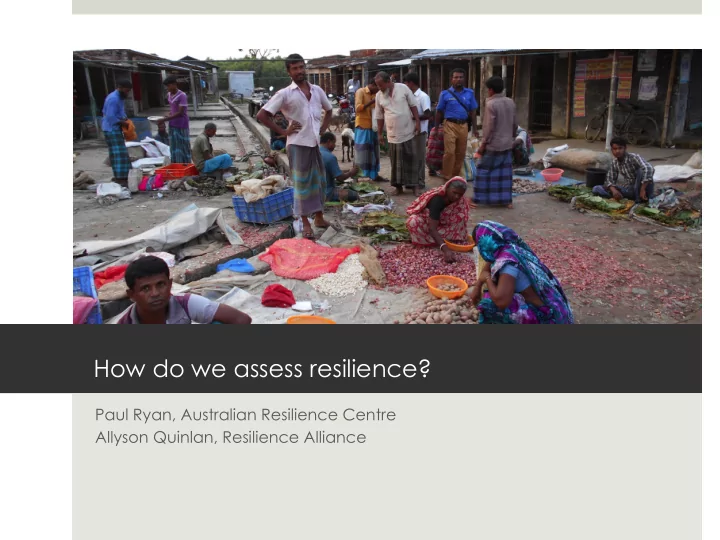

How do we assess resilience? Paul Ryan, Australian Resilience Centre Allyson Quinlan, Resilience Alliance
Introduction q Presenters q Structure of this weeks session q Overview (Paul) ü Conceptual framing ü Overview of resilience assessment ü Phases of resilience assessment ---------------------------------------------------------------------- q Discussion session (Allyson)
Framing q Social-ecological systems ü people and place are tightly enmeshed ü co-evolving, complex adaptive systems ü non-linear dynamics – unexpected interactions, change and unintended consequences, fast and slow dynamics
Social-ecological systems
Framing q Social-ecological ü people and place are tightly enmeshed ü co-evolving, complex adaptive systems ü non-linear dynamics – unexpected interactions, change and unintended consequences, fast and slow dynamics ü multi-scale – influenced by scales above and below
Drivers Shocks Climate Change Drought Stabilize Population Fire Social attitudes Flooding Economics and trade Famine Policy Conflict Low soil fertility Disease Change Price Stabilize Technology Innovation
Framing q Social-ecological people and place are tightly enmeshed ü co-evolving, complex adaptive systems ü non-linear dynamics – unexpected interactions, change and ü unintended consequences multi-scale – influenced by scales above and below ü q Participatory approach – agency based approach, people within the system understand the system best q Iterative process – you never get it right first time round! q Not a set recipe – always have to adjust the process for context q Consider ethics, power and gender in process design
Framing Recognition of a Resilience problem AND an based goal to take a interventions Resilience assessment and resilience based within the implementation approach to system of management interest
Framing Resilience assessment, implementation and learning Purpose of a resilience assessment: To identify, implement and learn from a minimum set of interventions that influence critical dynamics within the system in order for the system to adapt or transform towards more desirable trajectories in the face of known and unknown drivers and shocks
What is a resilience assessment? q Process of engaging with people within a particular system to develop sufficient understanding of the system dynamics to identify key intervention points (leverage points)and design actions to influence those leverage points q In practice it involves gathering (from stakeholders and technical sources),organizing and synthesizing information to allow greater insight into how a system is structured and how it functions
Phases of a resilience assessment 1 Preparation phase 2 Describing the system* 3 Analyzing system dynamics* 4 Designing interventions* 5 Designing implementation process 6 Implementing and learning
Describing the system (resilience of what?) q Objective: to develop a sufficient understanding (conceptual model)of the basic structure and function of the system to allow deeper analysis in the next phase boundaries and scales, climate, ecosystems, natural disturbance ü regimes land uses, relationship between people and landscape, values, ü benefits, goods and services generated, governance, tenure, aspirations – what do stakeholders want the system to be like? Are their ü aspirations being met? Drivers, trends and shocks that impact on aspirations, values and ü benefits Key issues (in context of aspirations, drivers and shocks) are described ü
Describing the system q Key practices and tools ü Interviews, surveys, workshops ü Literature reviews ü Historical timelines ü Ecosystem service mapping ü Basic social-ecological systems diagrams ü Influence diagrams q Outputs ü Agreed conceptual model of the system with issues identified
Modified from Chapin et al. 2012
Analyzing system dynamics (the resilience to what?) q Objective: identify intervention points to address issues that reduce the adaptive and transformative capacity of the system in relation to known and unknown drivers and shocks ü Building on system description, focus in on issues within the system ü Explore the dynamics of issues within a systemic context ü Identify critical variables associated with thresholds and tipping points ü Assess general capacity to manage unknown drivers and shocks
Analyzing system dynamics q Key practices and tools ü 3x3 matrix – scales, domains and thresholds, links between thresholds ü State and transition models for thresholds of potential concern
Analyzing system dynamics q Key practices and tools ü 3x3 matrix – scales, domains and thresholds, links between thresholds ü State and transition models for thresholds of potential concern q Outputs ü Critical dynamics and intervention points identified ü Cross scale interactions mapped ü Key interventions identified
Designing interventions (so what?) q Objective: to design interventions and an implementation process that builds knowledge (tests assumptions and strengthens evidence) and builds capacity of actors within the system to adapt or transform towards desirable futures. designing adaptive, learning implementation approach ü develop design and filtering criteria to ensure interventions are ü effective, efficient, achievable (technically, socially and economically feasible), minimize unintended consequences design pilots or trials to test the interventions ü design scaling up and out process ü design implementation to be safe fail, transparent, ethical and fair ü
Recommend
More recommend